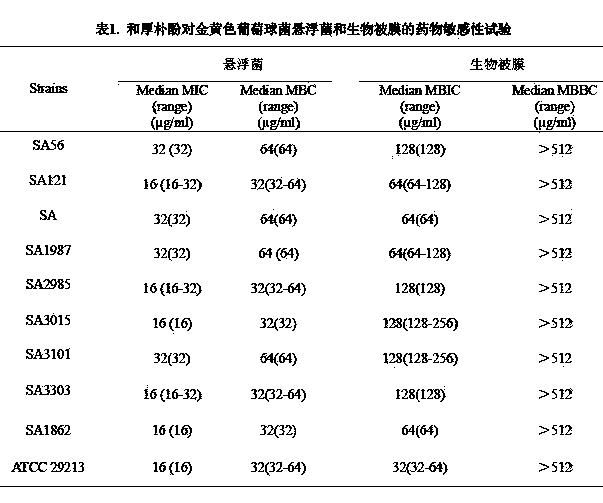Application of honokiol in inhibiting staphylococcus aureus biofilm
A technology of staphylococcus and honokiol, applied in the field of biomedicine, can solve the problems of repeated attacks and serious infections that cannot be cured for a long time
- Summary
- Abstract
- Description
- Claims
- Application Information
AI Technical Summary
Problems solved by technology
Method used
Image
Examples
Embodiment 1
[0020] Microdilution method for drug sensitivity test: Dilute the stock solution of honokiol with MHB medium, and add 100 μL per well to a 96-well plate. Dilute the bacterial solution from the overnight culture with MHB medium to an OD600 of 0.4 (equivalent to 5 × 10 8 CFU / mL) and further diluted to a concentration of 10 6 CFU / mL. 100 μL of bacterial suspension was added to each well, MHB was used as negative control, and bacterial suspension without drug was used as positive control. After mixing evenly, it was placed in a 37 °C incubator for static culture, and the results were observed after 24 h. The lowest concentration that can inhibit bacterial growth is the MIC value of the strain. The bacteria in each well are pipetted evenly and then poured into the MHA plate. The lowest concentration that does not grow bacteria is the MBC value. The experiment was repeated 3 times, and the median was taken as the final value. and honokiol against Staphylococcus aureus suspensio...
Embodiment 2
[0022] Drug susceptibility test by plate wiping method: single colonies from solid TSB culture plates were put into test tubes containing 5 mL of TSB, and placed in a shaker at 37 °C for overnight culture at 180 r / min; the bacterial solution was cultured with TSB (containing 0.5% glucose) Base diluted to an OD600 of 0.4 (equivalent to 5 × 10 8 CFU / mL) and further diluted to a concentration of 10 5 CFU / mL; carefully add 200 μL of diluted bacterial solution to each well of a 96-well plate, and place it in a 37 °C incubator for 24 h. After the biofilm was formed, the suspension was discarded, and 250 μL of PBS was added to each well to gently wash off the free bacteria. The drug was serially diluted twice in TSB medium (0.0625-512 μg / mL) and added to each well. Incubate at 37°C for 24 h. The suspension was discarded, washed once with PBS, and 250 μL of PBS was added. After blowing the biofilm evenly, 10 μL of each well was spread on TSA, and incubated at 37 °C for 24 h. The ...
Embodiment 3
[0025] Disc diffusion method experiment: use sterile cotton swabs to spread the bacteria on the plate medium, sterilize the tweezers with an alcohol lamp flame and stop for a while, and take the drug sensitive tablets and stick them on the surface of the plate medium regularly. The plate medium was placed in a 37°C incubator for 24 hours, and the effect was observed. When the drug concentration increased, the inhibition zone also increased significantly (see figure 2 ).
PUM
 Login to View More
Login to View More Abstract
Description
Claims
Application Information
 Login to View More
Login to View More - R&D
- Intellectual Property
- Life Sciences
- Materials
- Tech Scout
- Unparalleled Data Quality
- Higher Quality Content
- 60% Fewer Hallucinations
Browse by: Latest US Patents, China's latest patents, Technical Efficacy Thesaurus, Application Domain, Technology Topic, Popular Technical Reports.
© 2025 PatSnap. All rights reserved.Legal|Privacy policy|Modern Slavery Act Transparency Statement|Sitemap|About US| Contact US: help@patsnap.com



